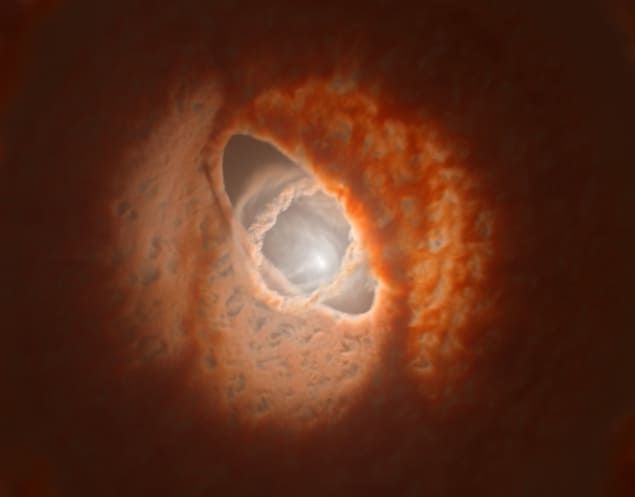
The young triple star system GW Orionis appears to be surrounded by a ring of gas and dust that has torn away and become misaligned with the rest of the system’s circumstellar disc. That is the conclusion of an international team of astronomers led by Stefan Kraus at the University of Exeter – who combined observations with numerical simulations to identify disc structures that have been confined to theory until now.
Astronomers believe that most stars are born with one or more companions, which interact in complex ways with the disc of planet-forming gas and dust surrounding the stellar system. If this disc is misaligned with the orbital planes of the host stars, previous simulations have predicted that it will warp and tear under their gravitational torque, forming distinct rings in separate planes from the rest of the disc. So far, however, astronomers have yet to identify this tearing in their observations of misaligned discs.
In their study, Kraus’ team aimed to verify this tearing process by making detailed observations of the triple star system, GW Orionis. At just around 1 million years old, the system’s circumstellar disc has yet to collapse to form planets; while at its centre, the orbital planes of its three stars are highly misaligned with each other. Over 11 years beginning in 2008, the researchers used the Very Large Telescope (VLT) and Atacama Large Millimeter Array (ALMA) telescopes in Chile to measure thermal emissions and scattered visible light originating from the system. This allowed them to map the distribution of material in the disc.
Casting a shadow
The team identified three distinct rings from these measurements; the outer two of which are closely aligned with each other, but not with the innermost. Containing roughly 30 Earth masses of material, this innermost ring is highly misaligned both with the circumstellar disc, and the orbital planes of its three host stars. This means that the ring casts a shadow on the rest of the disc, allowing the astronomers to define its 3D shape and orientation.
The team followed up these observations with advanced numerical simulations of GW Orionis. As they hoped, the innermost part the virtual disc warped and tore off into a separate, misaligned ring, with the same shape as they had observed. By tearing material out of the main disc in this way, such a ring could potentially form planets with exotic tilted orbits and long orbital periods; and which may even travel in the opposite directions to the rotations of their host stars.
These ideas will be explored in more detail through further observations with both the VLT and ALMA, potentially leading to discoveries of newly formed planets within the GW Orionis system. In turn, theories about such formation mechanisms could uncover an as-yet unknown population of exoplanets in binary and tertiary systems.
The research is described in Science.



